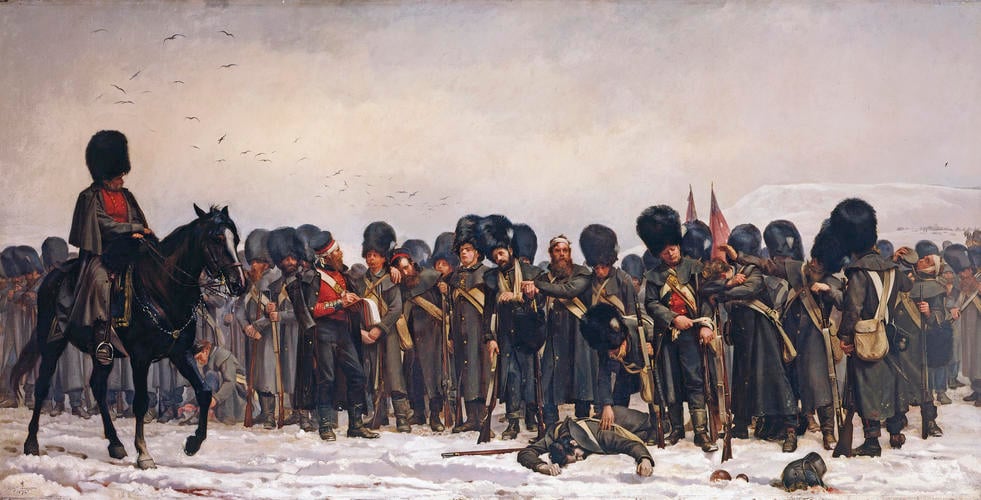-
1 of 253523 objects
The Roll Call Signed and dated 1874
Oil on canvas | 93.3 x 183.5 cm (support, canvas/panel/stretcher external) | RCIN 405915
-
In the cold light of morning, the remnants of a battalion of Grenadier Guards, many exhausted and wounded, are answering a roll call in the aftermath of a battle. While the artist, Elizabeth Southerden Thompson Butler, intended the painting as an archetypal image of the Crimean War (1854-6), it was generally assumed that the scene represented the aftermath of the Battle of Inkerman, which took place on the 5th November 1854.
The Roll Call captured the imagination of the country when exhibited at the Royal Academy in 1874, turning the artist into a national celebrity. So popular was the painting that a policeman had to be stationed before it to hold back the crowds and it went on to tour the country in triumph. The painting's focus on the endurance and bravery of ordinary soldiers without reference to the commanders of the army accorded with the mood of the times and the increasing awareness of the need for social and military reforms.
Though the public had been exposed to other images of the Crimean War, primarily prints, photographs and newspaper illustrations, never before had the plight of ordinary soldiers been portrayed with such realism. Butler researched her subject by studying A. W. Kinglake's seminal history of the Crimean War, as well as by consulting veterans of the Crimea, several of whom served as models for the painting. She also painstakingly sought out uniforms and equipment from the Crimean period in order to be correct in the smallest military details. The sombre mood and simple yet dramatic composition Butler achieved in The Roll Call vividly epitomised the grimness not only of the Crimean War but of all wars.
Elizabeth Butler née Thompson had spent many years in Italy as a child and there had been encouraged to engage with the arts. She first began to take lessons in painting in London in 1862 and subsequently enrolled at the Female School of Art at South Kensington. In 1866 she returned to take advanced classes and in 1869 travelled to Florence to study at the Academy of Fine Arts. A turning point in her career occurred when she was witness to some military manoeuvres in Southampton in 1872 and she began to specialise in military subjects. Her works were greatly influenced by contemporary French military painters, including Jean-Louis Meissonier and Edouard Detaille, whom she admired. Though she exhibited at the Royal Academy between 1873 and 1920, she was never again able to match the success of The Roll Call.
Though originally commissioned by wealthy Manchester industrialist Charles Galloway; following the Royal Academy exhibition both The Prince of Wales and Queen Victoria were keen to buy The Roll Call. Galloway eventually ceded it to The Queen, who had been concerned about the ordeals faced by soldiers during the Crimean War, which she noted, was won by 'their persevering valour and chivalrous devotion'.Provenance
Commissioned by the Manchester industrialist, Charles Galloway for £126; ceded to Queen Victoria in 1874
-
Creator(s)
Acquirer(s)
-
Medium and techniques
Oil on canvas
Measurements
93.3 x 183.5 cm (support, canvas/panel/stretcher external)
122.3 x 214.0 x 14.3 cm (frame, external)
Category
Object type(s)
Other number(s)
Alternative title(s)
The Roll Call: calling the roll after an engagement, Crimea
